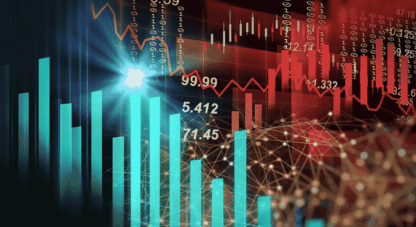One of the most helpful and thoughtful analysts writing an electronic newsletter these days has recently pooh-poohed the buying of gold. He’s proof, perhaps, that, while even a blind hog finds an occasional acorn, even a sharp-eyed eagle misses an occasional hare.
He writes that, “The biggest purveyors of economic collapse are those selling gold and silver. How they can continue to convince millions to invest in gold and silver when they have been continually manipulated and stagnant is beyond me. Yes, there is real value there, but it certainly isn’t keeping pace with inflation… And I don’t expect all those bullish claims of a breakout in price to come through.”
Et tu, Brute? Yes, gold has always had its enemies, and some appear as “yes, it’s good, but…” friends. Such “friends” miss some important points, as occurs in the above quotation.
To start with, the writer is referring to the price of precious metals being manipulated. Price, in America, means an item’s exchange rate in dollars. And dollars are one of the most manipulated things on the face of the earth—right up there with emotions in an election year.
You might have been an investor in Asian markets leading up to 1997, technology companies leading up to 2000, real estate leading up to 2008, gold or silver leading up to 2011, or stocks leading up to 2023 or 2024. What do those investments have in common? In America, they were/are priced in dollars. Most of their dollar valuations have peaked and then crashed. And all of these investments that are beyond their peak dollar valuations still have substantial absolute value, and even dollar value—some of them as much or more than when they previously peaked.
You see, manipulation can change an investment’s route, but not its destination. Those of us in the hard money camp have been surprised at the power of the manipulators over the past several decades, but at the end of the day they remain human and finite. Things like technology, real estate, well-run companies, and precious metals still have immense value, but stack them up next to a wildly erratic thing like the dollar and their “equivalence” is going to vary greatly.
Clearly, in that light, investing is not an autopilot endeavor. Even investors who buy and hold put in immense effort, research, patience, and thought before buying an investment they believe is deeply undervalued. And companies that care about their customers and clients put in great effort to educate them on how to invest successfully. They’re not just purveyors of hot tips or products, they’re investors in the people they do business with in hopes that those people will in turn invest successfully for the future.
This is our intent with the communications summarized below, along with other publications on this website. We hope you find them of use.
Key Takeaways:
- When politics trump national interest
- The history of leveraged speculation
- The consumer is at the end of his rope
- An important value in chart analysis
The McAlvany Weekly Commentary: David and Kevin examine currency exchange rates, energy costs, the strategic petroleum reserve, and the effects energy has on inflation this week. The SPR has been used to manipulate consumer prices in election years by both parties, but the reserve is getting low—historically low—and further drawdowns endanger the storage caverns in which it is kept. “The SPR was created in the 1970s so a sudden supply shock could never again impact the US. It was meant for a national emergency, not a personal emergency, buying down the oil price as a gift to potential voters.” The hosts also discuss Asian currency woes and the fact that gold is at all-time highs against the yen, renminbi, and rupee. The breakout in price sneered at by the writer quoted in the intro above is showing signs of imminence in many places in the world. Crucially, the hosts also deal with differences between today’s inflation fight in the U.S. and Volker’s in the early ’80s. Volker’s tool of extremely high interest rates is not available to Powell. The amount of debt in the economy today coupled with the cost of refinancing it as interest rates rise simply will not permit that kind of inflation medicine.
Credit Bubble Bulletin: Albert Einstein observed that, “The most powerful force in the Universe is compound interest.” Surely the mathematical genius should have known that compound understanding is even more powerful. The fact is demonstrated—as is frequently the case—in CBB this week. Doug looks back at the collapse of Long-Term Capital Management and then examines its enduring effects. He begins with a priceless and hilarious quotation from the Street, and then launches into a cautionary tale concerning leveraged speculation few people on the planet are capable of putting together. As he begins his conclusion, he notes that, “There are today eerie parallels to the period leading up to the Russia/LTCM crisis. After all the 1994-1997 global instability, the global leveraged speculating community should have been cautious. They had instead been emboldened by the Fed, ‘the committee to save the world’ (Greenspan, Rubin and Summers), the GSEs, the IMF, and the global central bank community.” Yes, history does sometimes rhyme. Other times, one hears strains of Sonny and Cher and watches Punxsutawney Phil predict six more weeks of human peccability. Exactly like yesterday.
Hard Asset Insights: There are many times when Morgan’s phrasing captures the subject perfectly, “Just this week an update to the U.S. national economic accounts revised away a full $1.1 trillion of U.S. household savings previously assumed to have been accumulated over the past six years. Even before the negative household savings revision, JPMorgan (and countless others) had concluded that excess savings, the supposed lifeline of the consumer, have already been completely spent. In a related revision this week, U.S. personal consumption for the second quarter was more than halved from an initial 1.7% to the much weaker figure of 0.8%. The joke is gaining traction among those following the data that claims of a ‘strong’ economy now come with an expiration date. Strength lasts only until data revisions erase it, leaving weakness in its wake.” Given that consumer spending drives 70% of the economy, Morgan gives it its due each week, noting that Atlas is getting a backache and needs to put the world down for a bit. The consequences for the economy cannot be but dire.
Golden Rule Radio: Tory and Miles step behind the mic this week, and take a look at the gold chart since the last program aired. They mentioned a high probability of breakout last week, which happened, but in a different direction than suspected. This brings up an important aspect of technical analysis that often goes unappreciated. Clearly it does not offer a crystal ball for investors. What it does offer is a map of where we are currently in a historical context, coupled with probabilities of future activity. How is this helpful? Well, the hosts are careful to share many observations on the program that describe crucial precepts investors should know about. One of these is the dollar cost averaging of purchases of precious metals. PMs do not vary in composition or usefulness, and they vary only within a range in the value ascribed to them by purchasers. This is what makes PMs valuable as insurance for your portfolio, but it’s not optimal to buy them all at once unless they’re at very low ebbs in their price performance. So you’ll hear that the hosts commit a given dollar amount to PM purchases each month, but they tend to double or triple up on their purchases when strong value opportunities present themselves. How do you know about such opportunities? Keep an eye on the charts—or on Golden Rule Radio, which watches the charts for you.















